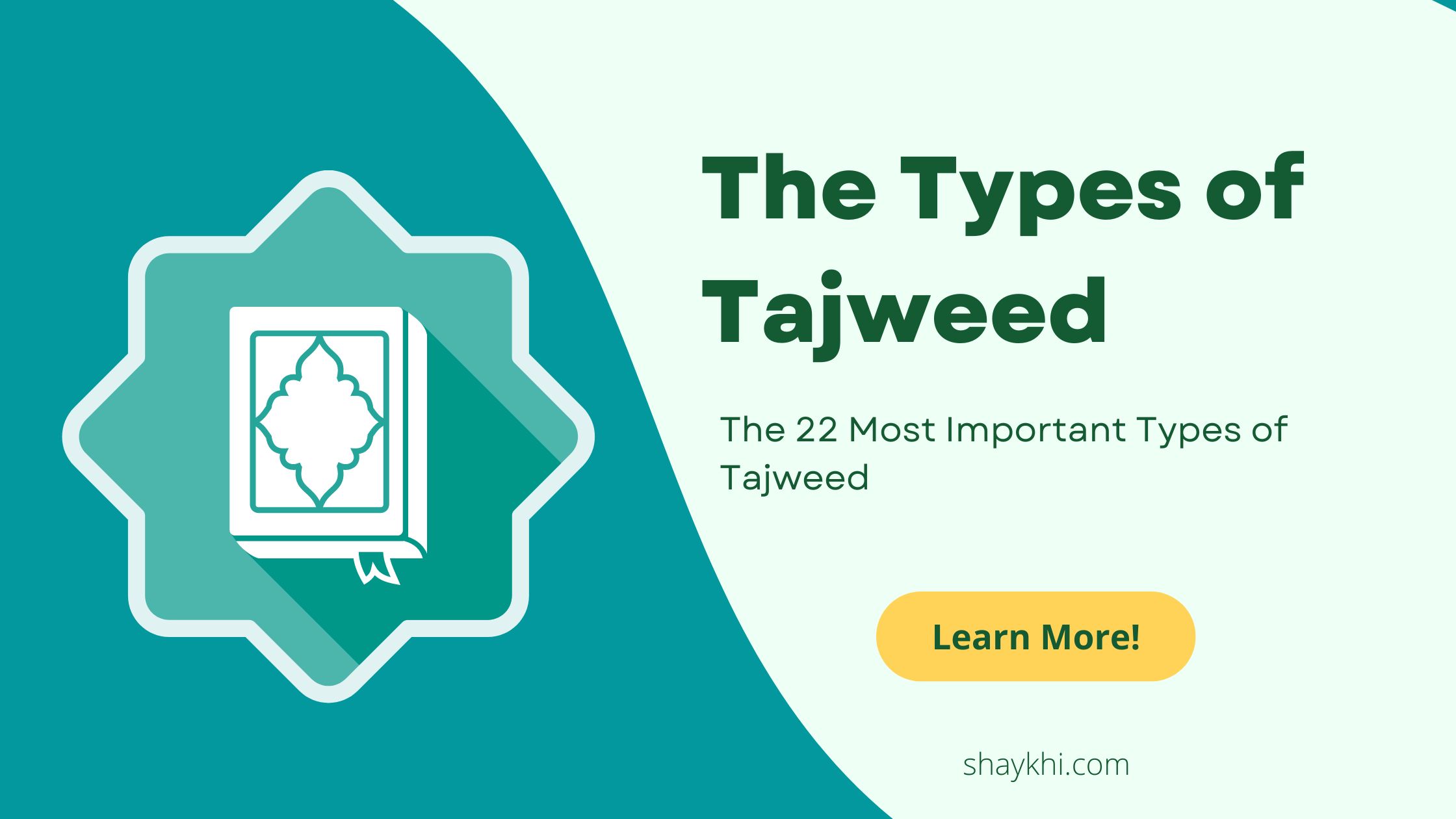Learning the many types of Tajweed rules and delving into the advanced rules of Tajweed unlocks a deeper connection to the Quran’s timeless eloquence.
Among others, the nuances of the different types of Alif, the delicate handling of silent letters, and the subtle distinctions between Shamsiyah and Qamariyah Lam all contribute to a recitation that honors the divine beauty of the Quran.
By embracing these Tajweed principles, reciters not only refine their pronunciation but also immerse themselves in the rich spiritual tapestry woven through every verse, allowing the words to resonate with their full intended majesty.
What Are the Types of Tajweed?
There are many types of Tajweed rules refer to the set of rules governing the pronunciation of letters in the Quran to ensure that each letter is given its due rights and articulated correctly. Therefore, it is crucial in the Quran recitation courses at Shaykhi Academy.
The types of Tajweed are generally categorized based on the specific aspects of pronunciation they cover:
1- Waqf and Ibtida (الوقف والابتداء):
The rules for stopping (Waqf) and beginning (Ibtida) in Quranic recitation serve as essential guidelines to ensure that the recitation is conducted without altering the meaning of the verses. Here is an explanation of these rules:
A- Al-Waqf (Stopping – الوقف):
In the Arabic language, Waqf means to stop or pause. It involves halting the sound and pausing at the end of a word for a brief moment, typically to take a breath, with the intent to continue reciting afterward.
Al-Waqf can be classified into two types:
1- Compulsory Stop (Waqf Idtirari):
This occurs when the reader is forced to stop due to an external factor such as sneezing, shortness of breath, coughing, or forgetting.
2- Optional Stop (Waqf Ikhtiyari):
This occurs when the reader stops by choice. It is further divided into:
a- Waqf Taam (Perfect Waqf/وقف تام):
This typically occurs at the end of a verse where the meaning is complete. The reader stops and takes a breath before continuing.
b- Al-Waqf Al-Hassan (الوقف الحسن):
This occurs when the reader stops at a meaningful statement, which may occur at the end or middle of a verse. It is connected to what follows in meaning, allowing the reader to stop but not continue without proper context.
c- Al-Waqf Al-Qabeeh (الوقف القبيح):
This occurs when stopping or starting with the following word is not recommended, as it can alter the meaning or lead to inappropriate inferences about Allah Almighty. For instance, stopping after the word “يغفر” in the verse
(إِنَّ اللَّهَ لَا يَغْفِرُ أَن يُشْرَكَ بِهِ وَيَغْفِرُ مَا دُونَ ذَٰلِكَ لِمَن يَشَاءُ ۚ)
would be improper.
B- Al-Ibtida (Starting – الابتداء):
Linguistically, Ibtida means to begin. In Tajweed, it refers to starting the recitation after a pause.
While stopping (Waqf) may be involuntary, starting the recitation (Ibtida) is always a matter of choice. Therefore, the reader must select a starting point that is independent and conveys the intended meaning of the verse without relying on the preceding context.
Types of Ibtida:
a- Good Starting (Ibtida Hasan):
This involves starting with a phrase that is independent in meaning and aligns with the intended message of Allah without contradicting it.
b- Bad Starting (Ibtida Qabeeh):
This involves starting with a phrase that distorts the meaning or implies something contrary to what Allah intended, making it impermissible.
2- Harakat in Tajweed (الحركات في التجويد):
In Tajweed, the term “harakah” refers to the movement or duration of a letter’s pronunciation. Harakat regulate the pronunciation of elongations (madd) and nasal sounds (ghunnah).
A harakah is equivalent to half of an alif maddiyyah (a prolonged alif). Therefore, two harakat (حركتين) equal one full alif. For example, when instructed to extend a sound by one alif, it must be prolonged for the duration it takes to pronounce two short vowels, as seen in the pronunciation of (قَ قَ) or (ضُ رَ) from the word (ضرب).
3- Hamzat Al-Wasl in Tajweed (همزة الوصل):
Hamzat al-Wasl, or the connecting Hamza, is an extra Hamza that appears at the beginning of a word. It is pronounced when starting the word but is omitted when continuing the recitation.
When the word begins with a consonant, Hamzat al-Wasl is needed to pronounce the initial consonant. This rule applies only when starting the word since starting with a consonant alone is not permitted.
However, when the word is connected to the preceding word, Hamzat al-Wasl is not pronounced because the previous letter will already be vowelized. Hamzat al-Wasl appears in nouns, verbs, and particles.
Hamzat al-Wasl is named for its role in connecting the pronunciation of the consonant that follows it when starting the word. There are two primary conditions for pronouncing Hamzat al-Wasl:
A- Hamzat al-Wasl in Nouns:
Hamzat al-Wasl in nouns can either occur with a noun defined by “Al” (the definite article) or an indefinite noun without it.
Hamzat al-Wasl in the Definite Noun (with “Al” the Definite Article):
In a definite noun, Hamzat al-Wasl is always pronounced with a Fatha, as in the verse:
“الْحَمْدُ لِلَّهِ رَبِّ الْعَالَمِينَ” (Al-Fatihah 1:2)
(“Al hamdulillahi rabi al-alamin.”)
Hamzat al-Wasl in the Indefinite Noun (without “Al” the Definite Article):
In an indefinite noun, Hamzat al-Wasl is pronounced with a Kasra and appears in measured nouns on the patterns of Istif’al and Ifti’al, as well as in seven specific nouns in the Quran:
1- Ibn (son):
“عِيسَى ابْنَ مَرْيَمَ” (Maryam 19:34)
(“Essa ibn maryem.”)
2- Ibnah (daughter):
“ابْنَتَ عِمْرَانَ” (At-Tahrim 66:12)
(“Ibnata imran.”)
3- Imru’ (person):
“لِكُلِّ امْرِئٍ مِنْهُمْ” (An-Nur 24:11)
(“Lekul imre’en menhum.”)
4- Ithnayn (two):
“لَا تَتَّخِذُوا إِلَهَيْنِ اثْنَيْنِ إِنَّمَا هُوَ إِلَهٌ وَاحِدٌ” (An-Nahl 16:51)
(“La tattakhidu ilahayn ithnayn…”)
5- Imra’ah (woman):
“امْرَأَتَ عِمْرَانَ” (Aal Imran 3:35)
(“Imra’at imran.”)
6- Ism (name):
“اسْمُ رَبِّكَ” (Al-Alaq 96:1)
(“Ism rabik.”)
7- Ithnata ashrata (twelve):
“اثْنَتَا عَشْرَةَ” (Al-Araf 7:160)
(“twelve.”)
B- Hamzat al-Wasl in Verbs:
Hamzat al-Wasl in verbs is vowelized based on the vowel of the third letter of the verb. If the third letter has a Kasra or a Fatha, Hamzat al-Wasl begins with a Kasra, as in the verse:
1- “اضْرِب بِعَصَاكَ” (Ash-Shuara 26:63)
(“Idrib bi asak.”)
2- “اذْهَبُوا فَتَحَسَّسُوا” (Yusuf 12:87)
(“Idhhabu fatahassasou.”)
If the third letter of the verb is vowelized with a Dhamma, Hamzat al-Wasl begins with a Dhamma.
4- Rules of Raa in Tajweed (أحكام الراء):
The pronunciation rules for the letter “ر” (Ra) in Tajweed, depending on its position in a word and its diacritical marks (Fatha, Kasra, Damma) or sukun, are categorized into three groups:
A- Tafkhim (Emphasis) (تفخيم):
This rule applies to emphasizing the Ra in certain cases, such as when it has a Fatha, a Damma, or is in sukun after a Fatha or Damma.
B- Tarqiq (Softening) (ترقيق):
This rule applies to softening the Ra in cases such as when it has a Kasra or is in sukun after a Kasra.
C- Cases Where Tafkhim or Tarqiq is Permissible:
In some instances, either Tafkhim or Tarqiq is allowed, such as in specific words in the Quran where scholars have differing opinions.
5- Iqlab Rules in Tajweed (الإقلاب):
Iqlab refers to the transformation of a letter in Tajweed, specifically changing a non-vowelized “nun” (ن) or tanween into a clear “meem” (م) when it is followed by a “ba” (ب). This rule ensures smooth and correct recitation.
6- Rules of Ghunnah in Tajweed (أحكام الغنة):
Ghunnah refers to the nasal sound produced from the nasal cavity and is integral to the pronunciation of the Arabic letters “nun” (ن) and “meem” (م). This nasal quality lasts for a specific duration, always extending for two counts.
The sound is characterized by its nasal resonance and varies in intensity based on the context. The levels of ghunnah are categorized from the strongest to the weakest:
A- Highest Level (Mushaddad):
This level is found in stressed instances of “nun” or “meem” within a word. Examples include “إِنَّ الْمُسْلِمِينَ” (Indeed, the Muslims) [Al-Qasas: 52] and “هَمَّتْ بِهِ” (She desired him) [Yusuf: 25].
B- Second Level (Incomplete Assimilation):
This occurs when a non-vowelized “nun” or tanween is assimilated into “waw” or “yaa.” Examples include “وَمَن يَعْمَلْ” (and whoever does) [An-Nisa: 124] and “مِن وَرَائِهِمْ” (behind them) [Al-Jathiya: 33].
C- Third Level (Concealed):
True concealment happens when a non-vowelized “nun” or tanween precedes one of the fifteen concealment letters (ص-ذ-ث-ك-ج-ش-ق-س-د-ط-ز-ف-ت-ض-ظ). Examples are “مَاء ثَجَّاجاً” (abundant water) [An-Naba: 14] and “عَن صَلَاتِهِمْ” (from their prayer) [Al-Ma’arij: 23].
D- Fourth Level (Clear Non-Vowelized):
This level involves clearly pronouncing the non-vowelized “nun” or tanween from its articulation point when followed by one of the six throat letters (الهمزة والهاء والعين والحاء والغين والخاء). Examples include “أَنْعَمَ” (bestowed) [Al-Fatiha: 7] and “وَانْحَرْ” (sacrifice) [Al-Kawthar: 2]. It can also appear across two words, such as “مِنْ هَادٍ” (from a guide) [Al-Hadid: 13].
E- Fifth Level (Light Movements):
At this level, the non-vowelized “nun” and “meem” are pronounced lightly, as in “نُودِيَ” (was called) [Taha: 11].
7- Ikhfaa Rules in Tajweed (الإخفاء):
Ikhfaa involves pronouncing a non-vowelized letter with a nasal sound that falls between clear articulation (izhar) and assimilation (idgham). The ghunnah remains for two counts, producing a sound that is neither fully clear nor fully assimilated.
The fifteen letters of Ikhfaa are: ص، ذ، ث، ج، ش، ق، س، د، ط، ز، ف، ت، ض، ظ.
When a non-vowelized “nun” or tanween is followed by any of these letters, the Ikhfaa rule is applied. This requires pronouncing the non-vowelized “nun” or tanween with a sound that is intermediate between clear articulation and assimilation, accompanied by a two-count nasal sound. There are two main types of Ikhfaa:
A- True Ikhfaa (Ikhfaa Haqiqi):
Examples include:
– “يَنْصُرْكُمُ” (He will help you) [Al-Imran: 160]
– “مَنْ ذَا الَّذِي” (Who is that) [Al-Baqara: 245]
– “خَلْقٍ جَدِيدٍ” (A new creation) [Qaf: 15]
B- Lip Concealment (Ikhfaa Shafawi):
Occurs when a non-vowelized “meem” (م) is followed by a “ba” (ب). This is called lip concealment because both “meem” and “ba” are articulated with the lips. Examples include:
– “تَرْمِيهِمْ بِحِجارَةٍ” (Striking them with stones) [Al-Fil: 4]
– “بَلْ أَنْتُمْ بِهَدِيَّتِكُمْ” (But you, with your gift) [An-Naml: 36]
8- Idghaam Rules in Tajweed (الإدغام):
Idgham refers to the merging of a non-vowelized letter with another letter, resulting in a stressed pronunciation.
In Arabic, Idgham means inserting one element into another. In Tajweed, it refers to merging a non-vowelized “nun” or tanween with specific letters (“meem, nun, waw, ya, ra, lam”) to produce a stressed sound. This can occur within a single word or across two words.
Types of Idgham Based on Ghunnah Presence are:
A- Idghaam with Ghunnah:
This happens when a non-vowelized “nun” or tanween is followed by the letters “ya, nun, meem, waw” (grouped as “yanmu”). Examples include:
– “وَمَن يَعْمَلْ” (And whoever does) [An-Nisa: 124]
– “آياتٍ مُّبَيِّنَاتٍ” (Clear signs) [Al-Hajj: 16]
B- Idghaam without Ghunnah:
This occurs when “lam” or “ra” follows a non-vowelized “nun” or tanween. There is no nasal sound in this merging. Examples include:
– “مِّن لَّبَنٍ” (Of milk) [Al-Nahl: 66]
– “غَفُورًا رَّحِيمًا” (Forgiving, Merciful) [Al-Baqara: 173]
Types of Idgham Based on Completeness:
A- Complete Idgham (إدغام كامل):
This involves fully merging the non-vowelized “nun” or tanween with the letters “lam, ra, meem, nun,” leaving no trace of the original sound. Examples include:
– “مِن لَّدُنَّا” (From Us) [Al-Kahf: 65]
B- Incomplete Idgham (إدغام ناقص):
This involves partial merging with a trace of the original sound, with letters like “ya” and “waw.” Examples include:
– “خَيْرٌ لَّكُمْ” (Better for you) [Al-Baqarah: 184]
C- Lip Idgham (Idgham Shafawi):
This applies to non-vowelized “meem,” where it merges with a following “meem” with a nasal sound. It is also known as the assimilation of similar letters. Example:
– “لَكُمْ مَا” (For you what) [Al-Nisa: 3]
9- Tajweed Madd Rules:
Elongation (Madd) involves extending the sound with a letter of elongation or one of the letters of softness.
Letters of Madd are:
– The silent “Alif” preceded by a “Fatha”
– The silent “Yaa” preceded by a “Kasra”
– The silent “Waw” preceded by a “Dhamma”
The types of Madd are:
A- Original Madd (مد أصلي):
Original Madd is dependent on the inherent presence of the letter and does not require any additional reasons for its extension. It lasts for two Harakaat (counts), and its duration can be estimated by the time it takes to pronounce two consecutive letters “قَ قَ”.
The categories of original Maad include:
– Natural Madd that remains consistent whether stopping or continuing.
– Natural Madd that is consistent in stopping but not in continuing.
– Natural Madd that is consistent in continuing but not in stopping.
– Natural Madd in the spelling of the openings of some surahs.
B- Secondary Madd (مد فرعي):
Secondary Madd depends on external factors for its extension. It can be classified as:
a- Secondary Madd due to a Hamza:
This includes Madd Badal, Mandatory Connected Madd (Madd Wajeb Muttasil), and Permissible Disconnected Madd (Madd Jaiz Munfasil).
b- Secondary Madd due to Sukoon:
This includes Mandatory Madd (where the Sukoon is fixed) and Contingent Madd due to Sukoon (where the Sukoon is contingent upon stopping and disappears when continuing).
10- Makharej Al-Huroof in Tajweed (مخارج الحروف):
The articulation points (Makharij al-Huruf) are crucial for accurate Tajweed and help refine pronunciation. Each letter has a specific articulation point where its sound originates and ends. There are five general articulation points divided into seventeen specific points: the tongue, the lips, the nasal passage, the oral cavity, and the throat.
To identify the precise articulation point, one can insert a Hamzat al-Wasl (linking Hamza) before the letter to determine where the sound begins and ends.
11- Sefat Al-Huroof (صفات الحروف):
In Arabic, a characteristic describes the inherent state of a letter when pronounced. Understanding these characteristics is essential for distinguishing between letters with similar articulation points, improving pronunciation, and understanding which letters can merge into others (Idgham).
These principles are fundamental for proper recitation and maintaining the integrity of Quranic pronunciation.
12- Sukoon in Tajweed (السكون في التجويد):
In Tajweed, a sukoon indicates a letter that should be pronounced without any of the three vowel marks (fatha, kasra, or damma). This silent pronunciation requires precision and control to avoid exaggeration.
The sukoon plays a significant role in maintaining the rhythm and flow of Quranic recitation. Certain letters with sukoon, such as the silent noon (النون الساكنة) or silent meem (الميم الساكنة), have specific rules that must be observed.
For instance, the silent noon in the word “الْأَنْهَارُ” must be pronounced clearly, adhering to the rules of Izhar, without adding any additional sound or stress beyond what is required.
13- Rules of the Silent Noon and Tanween (أحكام النون الساكنة والتنوين):
These rules govern the pronunciation of the silent noon (ن) and tanween (ً, ٍ, ٌ) when they are followed by certain Arabic letters. Since tanween is essentially a silent noon pronounced at the end of nouns, the rules apply to both the silent noon and tanween. There are four key rules:
A- Izhar (الإظهار):
Izhar means “clarity” or “making clear.” This rule is applied when a silent noon or tanween is followed by one of the six throat letters: Hamza (ء), Ha (ه), ‘Ayn (ع), Ha (ح), Ghain (غ), Khaw (خ). In this case, the silent noon or tanween is pronounced clearly without any nasalization.
Examples include:
“مَنْ أَمِنَ” (Whoever believes) [Al-Baqarah: 277]
“أَنْعَمْتَ” (You have bestowed) [Al-Fatiha: 7]
B- Idgham (الإدغام):
Idgham means “merging.” When a silent noon or tanween is followed by one of the letters of idgham, the noon or tanween is merged into the following letter. There are two types of idgham:
a- Idgham with Ghunnah:
This occurs when the silent noon or tanween is followed by the letters Ya (ي), Noon (ن), Meem (م), or Waw (و). The noon or tanween is merged into the following letter with a nasal sound (ghunnah).
Examples include:
“مِنْ نِعْمَةٍ” (Of any favor) [An-Nahl: 53]
“مَنْ يَعْمَلْ” (Whoever does) [An-Nisa: 124]
b- Idgham without Ghunnah:
This occurs when the silent noon or tanween is followed by the letters Lam (ل) or Ra (ر). The noon or tanween is merged into the following letter without nasalization.
Examples include:
“مِنْ لَدُنْهُ” (From Him) [Al-Kahf: 65]
“غَفُورًا رَحِيمًا” (Forgiving, Merciful) [Al-Baqarah: 173]
C- Ikhfa (الإخفاء):
Ikhfa means “concealment.” It occurs when a silent noon or tanween is followed by one of the fifteen letters of ikhfa: Saad (ص), Dhal (ذ), Tha (ث), Kaf (ك), Jim (ج), Sheen (ش), Qaf (ق), Seen (س), Dal (د), Ta (ط), Zay (ز), Fa (ف), Ta (ت), Daad (ض), Zha (ظ). The noon or tanween is partially concealed, and a nasal sound is produced for two counts.
Examples include:
“مِنْ سُوءٍ” (From evil) [Al-Fil: 4]
“عَنْ طَرِيقٍ” (From the path) [Al-Kahf: 17]
D- Iqlaab (الإقلاب):
Iqlaab means “conversion” or “change.” When the silent noon or tanween is followed by the letter Ba (ب), the noon sound is converted into a meem sound, and a nasalization (ghunnah) of two counts occurs. The noon is not pronounced directly; instead, a hidden meem sound is produced.
Examples include:
“مَنْ بَعَثَنَا” (Who raised us) [Yasin: 52]
“سَمِيعٌ بَصِيرٌ” (All-Hearing, All-Seeing) [Ash-Shura: 11]
14- Rules of the Silent Meem (أحكام الميم الساكنة):
The silent meem (م) has specific rules that govern its pronunciation when followed by certain letters. These rules ensure proper articulation and clarity in recitation. There are three main rules:
A- Ikhfa Shafawi (الإخفاء الشفوي):
Ikhfa Shafawi occurs when the silent meem is followed by the letter Ba (ب). The meem is partially concealed, and a nasal sound (ghunnah) is produced for two counts. This rule is unique because both letters, meem and ba, are articulated using the lips.
Example include:
“يَرْمِيهِمْ بِحِجَارَةٍ” (Striking them with stones) [Al-Fil: 4]
B- Idgham Shafawi (الإدغام الشفوي):
Idgham Shafawi occurs when the silent meem is followed by another meem. The two meem letters are merged, and a nasal sound (ghunnah) is produced for two counts. This merging creates a stronger pronunciation of the meem.
Examples include:
“كَمْ مِمَّا” (How much of what) [An-Naba: 26]
C- Izhar Shafawi (الإظهار الشفوي):
Izhar Shafawi occurs when the silent meem is followed by any of the remaining letters of the Arabic alphabet, except for ba and meem. The meem is pronounced clearly without nasalization.
Examples include:
“وَهُمْ فِيهَا” (And they in it) [Al-Mumtahina: 7]
“عَلَيْهِمْ غَيْرِ” (Upon them, not) [Al-Fatiha: 7]
15- Noon and Meem Mushaddad Rules (أحكام النون والميم المشددتين):
The rules for Noon Mushaddad (نّ) and Meem Mushaddad (مّ) involve the pronunciation of two identical letters where the first is silent and the second has a vowel mark.
These letters are written with a shaddah ( ّ ), indicating that they should be pronounced as one stressed letter with a prolonged nasal sound (ghunnah) for two counts. This rule applies specifically to the noon and meem when they appear with a shaddah:
A- Noon Mushaddad (نّ):
In the word “فلنقصن” from the verse “فَلَنَقُصَّنَّ عَلَيْهِمْ بِعِلْمٍ” (Al-A’raf: 7), the noon is pronounced with a strong nasal sound, merging the two noon letters into one.
B- Meem Mushaddad (مّ):
Similarly, in words like “أَمَّا” (as for), the meem is pronounced with ghunnah, giving it a prolonged nasal tone.
These rules are essential for preserving the correct pronunciation and melody in Quranic recitation, ensuring that the reciter maintains the proper flow and emphasis as intended.
16- Qalqalah in Tajweed (القلقلة في التجويد):
Qalqalah refers to a unique Tajweed rule where specific letters are pronounced with a slight echoing or vibrating sound. This occurs when one of the qalqalah letters (ق, ط, ب, ج, د) is silent, either in the middle or at the end of a word.
The purpose of qalqalah is to enhance the clarity and distinctness of these letters, especially in silent positions, where the sound might otherwise be lost.
For example:
A- Silent Qaf (القاف): In the word “مقعد” (a seat), the qaf is pronounced with a slight echo.
B- Silent Dal (الدال): In the word “صدق” (truth), the dal is emphasized with a vibrating sound.
C- Silent Qaf (القاف): In the verse “فِي مَقْعَدِ صِدْقٍ عِنْدَ مَلِيكٍ مُقْتَدِرٍ” (Al-Qamar: 55), the qaf in “مقتدر” is pronounced with a strong qalqalah.
17- The Rules of Meeting Two Silent Letters (التقاء ساكنين):
In Quranic recitation, it is generally impermissible to combine two consecutive silent letters within a word or across two words. However, specific rules exist to manage these situations.
A- Meeting Two Silent Letters in One Word:
There are two cases where it is permissible to have two silent letters in one word:
a- First Letter is a Long or Soft Letter:
The first silent letter is typically a long vowel or a soft letter. Examples include: “الضّالِّين” (al-Dalleen) where the long vowel is followed by a silent letter.
b- Second Letter is Silent Due to Stopping:
When stopping on a word causes the second letter to become silent. Example include: “وَالْعَصْرْ” (Wa al-Asr) where the last letter becomes silent due to a stopping condition.
B- Meeting Two Silent Letters Across Two Words:
When two silent letters meet across two words, Arabic grammar usually disallows this combination, so the following resolutions are applied:
a- Dropping the First Silent Letter:
If the first silent letter is a long vowel, it is dropped. Examples: “اتَّقُوا اللهَ” becomes “اتَّقُ الله” (Ittaqullah), “اهدِنَا الصِّرَاطَ” becomes “اهْدِنَ الصِّرَاطَ” (Ihdinasirat).
b- Moving the First Silent Letter:
If the first silent letter is a consonant, it is moved by adding a vowel (fatha, kasra, or damma):
– With Kasra (breaking): The first silent letter is moved with a kasra to avoid two silent letters meeting. Examples: “لَمْ يَكُنِ اللهُ” becomes “لَمْ يَكُنِ اللَّهُ” (Lam yakuni allah), “قُلِ الحَمْدُ لِلَّهِ” becomes “قُلِ الحَمْدُ لِلَّه” (kuli Alhamdulillah).
– With Damma (rounding): This occurs when the silent letter is a meem or waw connected to a pronoun. Example: “وَأَنتُمْ الأَعْلَوْنَ” becomes “وَأَنتُمُ الأعْلَوْن” (Wa antumu Al-A’aloun).
– With Fatha (opening): Applied when the preposition “مِنْ” precedes a word starting with “Al.” Example: “مِنَ المُؤْمِنِينَ” becomes “مِنَ المُؤْمِنِينَ” (Mina Al-mu’mineen).
18- The Levels of Tafkhim (Emphasis):
Tafkhim (emphasis) refers to the thickness of the sound, filling the mouth with resonance. There are five levels:
A- Open with an Alif After It:
This is the highest level of emphasis. For example, “قَالَ” (qaal), “طَائِفَةٌ” (Taaifa).
B- Open Without an Alif:
In this case, there is slightly less emphasis. For example, “خَيْرٌ” (khayr).
C- With a Damma:
For example: “يَصُومُ” (yasoum).
D- Silent (Sakin):
For example: “فَاصْبِرْ” (Fasber).
E- With a Kasra:
This case is the lowest level of emphasis. For example: “قِيلَ” (keel), “صِدْقٍ” (sedq).
19- The Rules of Tarqeeq in Tajweed (أحكام الترقيق):
Tarqeeq (light pronunciation) applies to most Arabic letters, with specific conditions for certain letters like Lam, Ra, and Alif.
A- Letters Always Pronounced Lightly (Tarqiq):
Most Arabic letters except Lam (ل), Ra (ر), and Alif (ا) under certain conditions.
B- Letters with Variable Emphasis:
a- Alif (ا): Follows the emphasis or lightness of the preceding letter.
Example: “التَّرَاقِي” (Altaraqi), “قَالَ” (qaal).
b- Lam (ل): The Lam in “Allah” is emphasized after Fatha or Damma, light after Kasra.
Example: “عَبْدُ اللهِ” (Abdullah) vs. “بِسْمِ اللهِ” (Bismillah).
c- Ra (ر): Four cases of pronunciation:
In some cases, it can be always light, preferably light but can be emphatic, preferably emphatic but can be light, or always emphatic.
20- The Definite Article “Alif Lam” (الـ التعريف):
Alif Lam” is a silent Lam preceded by an open Hamzat Wasl and is attached to a noun. It functions as the definite article “the” and can change the pronunciation depending on the following letters.
21- The Rules of Laam Shamsiya and Laam Qamariyah (أحكام اللام الشمسية واللام القمرية):
The rules of Laam Shamsiya and Laam Qamariya ensure correct Quranic recitation, preserving the beauty and precision of the language.
A- Qamariyah Lam (Moon Lam):
Applies to fourteen letters (أ, ب, غ, ح, ج, ك, و, خ, ف, ع, ق, ي, م, ه). The Lam is pronounced clearly. Examples: “الأَنْعام” (al-An’am), “الكتاب” (al-Kitab).
B- Shamsiyah Lam (Sun Lam):
Applies to fourteen other letters (ط, ث, ص, ر, ت, ض, ذ, ن, د, س, ظ, ز, ش, ل). The Lam is merged into the following letter. Examples: “الطارق” (al-Tariq), “الضالين” (al-Dalleen).
22- The Types of Alif in the Quran:
The letter Alif (ا) plays a crucial role in the proper recitation of the Quran. Understanding its various forms and uses is essential for mastering Tajweed rules and ensuring the correct articulation of Quranic verses. Here’s a summary of the different types of Alif found in the Quran:
A- Alif with a Small Circle Above:
This Alif is written but not pronounced, marked with a small circle (ه) above it. It is retained in the script but omitted in pronunciation when stopping or joining.
Examples: (ثَمُودَاْ) in Surahs like Hud (68), Al-Furqan (68), Al-Ankabut (38), and An-Najm (51).
B- Madd Alif (الألف المدية):
This Alif is always pronounced, whether stopping or joining, when followed by a vowel. It is omitted if followed by a silent letter to avoid the meeting of two silent letters.
Examples: Pronounced in
(فَلَمّا رَأَى القَمَرَ بازِغًا),
but omitted in
(فَلَمّا ذاقَا الشَّجَرَةَ).
C- Alif in Definite and Indefinite Nouns (ألف الاسم المقصور المنون):
This Alif appears in nouns, often written as a Yaa, and retains its pronunciation when paused upon, dropping the Tanween. It maintains its presence in the script but adjusts according to the grammatical context.
Examples:
(وَأَجَلٌ مُّسَمًّى عِندَهُ).
D- Dagger Alif (الألف الخنجرية):
This Alif is represented by a small Alif symbol in the script, pronounced but not written in certain words. It is extended naturally by two Harakaat, adding to the rhythm and beauty of recitation.
Examples: (أَهَـكَذَا) and (الرَّحْمَـٰنِ).
How Many Rules of Tajweed Are There?
The rules of Tajweed are numerous, as they cover all aspects of proper Quranic recitation. However, they are often organized into key categories that can be broken down into more specific rules.
These categories represent the foundational rules of Tajweed, and within each, there may be further sub-rules and details. The total number of core rules can be approximately 25 when considering the main guidelines.
However, scholars may categorize and count them differently depending on their approach to teaching and organizing the subject; the Tajweed courses of kids at Shaykhi Academy attempt to teach your kid the most essential rules in a simplified manner, where as the Tajweed courses for adults tends to have a broader approach.
Learn Tajweed with Specialized Arab Tutors at Shaukhi Academy
Unlock the beauty of Quranic recitation with our comprehensive Tajweed course at Shaykhi Academy. Whether you’re a beginner or looking to refine your skills, our expert instructors will guide you through the intricacies of Tajweed, ensuring you recite the Quran with precision and confidence.
Don’t miss the opportunity to deepen your spiritual connection and perfect your recitation. Enroll now and start your journey towards mastering the art of Tajweed!
Why Choose Shaykhi Academy?
- Connect with highly qualified native tutors.
- Flexible scheduling to suit your busy lifestyle.
- Affordable classes tailored for all levels.
- Accessible from anywhere around the globe.
Discover Our Range of Courses:
- Arabic Noorani Qaida: Lay a solid foundation for Quranic studies.
- Online Quran Classes for Kids: Engaging lessons for lifelong learning.
- Tajweed Rules for Kids: Learn to recite with confidence.
- Quran Hifz for Kids: Step-by-step guidance to memorize the Quran.
- Quran for Adults: Introduce yourself to Quran reading and Tajweed rules.
- Online Arabic Courses: Master the language of the Quran.
- Islamic Studies: A wide range of topics related to Islam, including theology, law, Quranic studies, and Hadith.
Don’t Miss Out on Your Chance to Excel! Whether you’re a beginner or seeking advanced knowledge, Shaykhi Academy can guide you! Book your free trial now
The Conclusion:
In conclusion, mastering the intricacies of Tajweed is essential for anyone seeking to recite the Quran with accuracy and beauty. Understanding advanced rules, such as the different forms of Alif, the meeting of two silent letters, and the specific pronunciation rules for Shamsiyah and Qamariyah Lam, enriches the reciter’s ability to preserve the divine eloquence of the Quran.
By learning and applying these Tajweed principles, one ensures that their recitation is not only correct but also resonates with the profound spiritual and linguistic depth intended in the Quranic revelation.













































